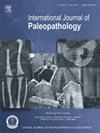评估颧骨骨样骨瘤:大形态学和显微ct研究。
IF 1.5
3区 地球科学
Q3 PALEONTOLOGY
引用次数: 0
摘要
目的:骨样骨瘤(Osteoid osteoma, OO)是一种良性的卵状骨肿瘤,主要影响下肢长骨,在颧骨上非常罕见。本文采用宏观和高分辨率显微计算机断层扫描(micro-CT)相结合的方法,对一例颧骨OO进行评估。材料:研究人员分析了一具35-50岁男性的骨骼遗骸,这些遗骸来自40号遗址62/2号(位于塞尔维亚北部Potes Gornje Sajlovo的阿瓦尔时期墓地40号遗址),时间在公元7世纪到9世纪之间。方法:我们对骨骼材料进行了生物人类学和古病理学分析,并对颧骨病变进行了高分辨率显微ct成像。结果:在左侧颧骨上发现一边界清楚的突出肿块。病变前后宽15.93 mm,中外侧宽14.92 mm,位于中心位置的病灶长6.74 mm,被硬化骨包围。结论:我们的研究代表了考古人群中罕见的颅面OO病例,突出了显微ct在古病理学中的诊断价值。意义:在考古学背景下记录OO有助于了解良性骨肿瘤的患病率和表现,可能为肿瘤生物学的进化提供见解。局限性:由于这是一个单例研究,概括是有限的。然而,它提供了颧骨OO的新的显微ct表现,突出了在古病理学研究中建立标准诊断标准的广泛应用的必要性。对进一步研究的建议:进一步的研究应该采用多学科和多尺度的方法,从人口水平的考古背景中调查这种或类似的骨骼病理状况。本文章由计算机程序翻译,如有差异,请以英文原文为准。
Evaluating an osteoid osteoma of the zygomatic bone: A macromorphological and micro-CT study
Objective
Osteoid osteoma (OO) is a benign, ovoid-shaped bone neoplasm that predominantly affects long bones of the lower limbs, making its presence on a zygomatic bone exceptionally rare. This paper evaluates a case of zygomatic OO, analyzed by integration of macroscopic and high-resolution micro-computed tomography (micro-CT) assessment.
Materials
The skeletal remains of a 35–50-year-old male from grave 62/2, Site 40 (Avar-period necropolis Site 40, Potes Gornje Sajlovo, northern Serbia), dated between the 7th and 9th centuries CE, were analyzed.
Methods
We performed bioanthropological and paleopathological analyses of skeletal material, along with high-resolution micro-CT imaging of the zygomatic lesion.
Results
A well-circumscribed, protruding mass was identified on the left zygomatic bone. The lesion measured 15.93 mm antero-posterior and 14.92 mm medio-lateral, with a 6.74 mm-long centrally positioned nidus surrounded by sclerotic bone.
Conclusions
Our study represents a rare case of craniofacial OO in an archaeological population, highlighting the diagnostic value of micro-CT in paleopathology.
Significance
Documenting OO in an archaeological context contributes to understanding the prevalence and presentation of benign bone neoplasms, potentially offering insights into the evolution of tumor biology.
Limitations
As this is a single-case study, generalizations are limited. Nevertheless, it provides novel micro-CT findings of the OO of the zygomatic bone, highlighting the need for broader application in paleopathological research to establish standard diagnostic criteria.
Suggestions for further research
Further research should employ a multidisciplinary and multi-scale approach to investigate this or similar skeletal pathological conditions from archaeological contexts at the population level.
求助全文
通过发布文献求助,成功后即可免费获取论文全文。
去求助
来源期刊

International Journal of Paleopathology
PALEONTOLOGY-PATHOLOGY
CiteScore
2.90
自引率
25.00%
发文量
43
期刊介绍:
Paleopathology is the study and application of methods and techniques for investigating diseases and related conditions from skeletal and soft tissue remains. The International Journal of Paleopathology (IJPP) will publish original and significant articles on human and animal (including hominids) disease, based upon the study of physical remains, including osseous, dental, and preserved soft tissues at a range of methodological levels, from direct observation to molecular, chemical, histological and radiographic analysis. Discussion of ways in which these methods can be applied to the reconstruction of health, disease and life histories in the past is central to the discipline, so the journal would also encourage papers covering interpretive and theoretical issues, and those that place the study of disease at the centre of a bioarchaeological or biocultural approach. Papers dealing with historical evidence relating to disease in the past (rather than history of medicine) will also be published. The journal will also accept significant studies that applied previously developed techniques to new materials, setting the research in the context of current debates on past human and animal health.
 求助内容:
求助内容: 应助结果提醒方式:
应助结果提醒方式:


